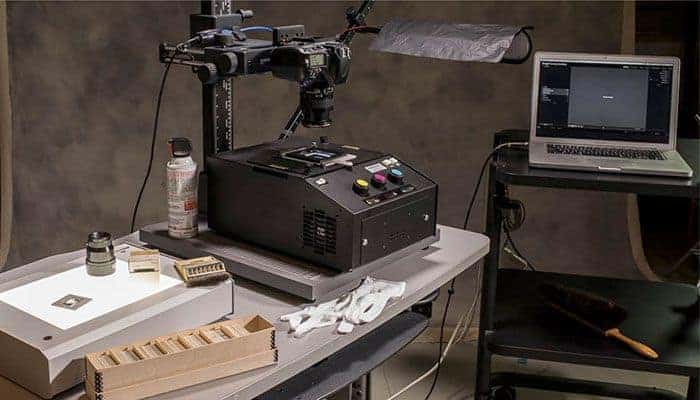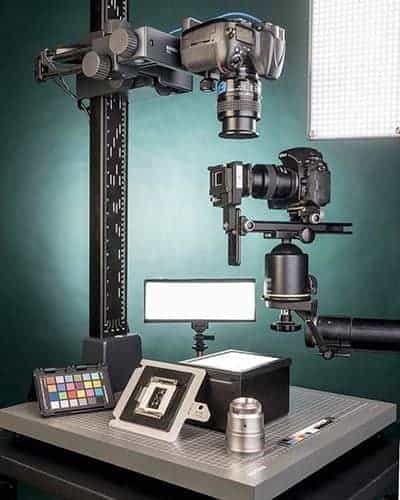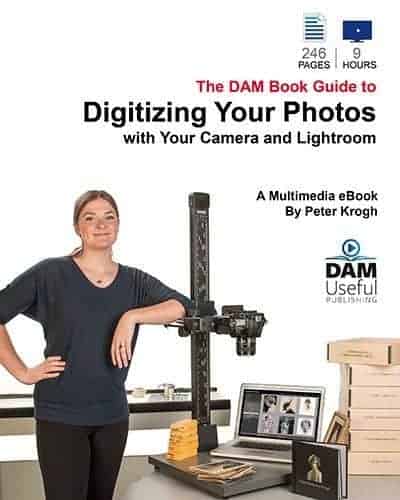
Photo: Peter Krogh
Everyone has a cache of photos, slides and negatives tucked away somewhere. They might be your images, family photos from your parents, or a film archive from your company. They all hold great value whether personal, sentimental or a business asset. It can seem like a huge responsibility:
- What are you going to do with them?
- How will you do it?
- How long will it take?
- And how much is it going to cost?
Chances are you would like to have your photos in a digital form to more easily access, share and if it’s a business, monetise them. Last month I wrote about converting video tapes to digital. Converting, or digitising, ‘analog’ prints and film can seem even more daunting. Traditionally photos and film would be carefully scanned by experienced technicians, one at time. Scans would be individually tweaked and cleaned up then saved as a TIF file. There is a much easier, faster, more cost effective way!
Camera Scans
Peter Krogh, commercial photographer and image collection management guru, coined the phrase Camera Scanning some 20 years ago. A digital camera is used to capture raw images of photos and film at high resolution.

Photo: Peter Krogh
Once the copy system is set up it’s a simple process to digitise and anyone with minimal training can do it. A huge advantage is expertise is only required at the backend, when the images are actually needed. Then they’re converted from camera raw format to TIF or JPEG. This saves you a lot of time and money. Traditional scanning puts the expertise at the capture stage, for every photo as it’s digitised. With decades of experience in scanning, slide duplication, photo copying, and digital asset management I’ve implemented the Camera Scanning system for at least three film archives and seen the results.
Digitising Photos with Your Camera – Step by Step
A decade ago Peter Krogh wrote a Camera Scanning white paper as part of the National Digital Information Infrastructure and Preservation Program for the US Library of Congress.

Photo: Peter Krogh
This month he released Digitizing Your Photos with Your Camera and Lightroom, a comprehensive multimedia ebook complete with 94 instructional videos to guide you through the whole process. Written, illustrated and produced in typical Krogh style the new book goes into great detail on the whole procedure from strategy to publishing options (social media, website, printed book, etc,).
Digitizing Your Photos video instruction
Based on the real world experience of digitising his fathers photographic archive you will see Peter and his daughter Josie go through the entire workflow. Whether your goal is more modest or demanding, the system Peter demonstrates scales perfectly.
The Problem with B&W and Colour Negatives
Copying slides has a long tradition and is made easier because we are making a digital copy of a positive image. Negative film, especially colour negs, create a digital negative that needs to be inverted in post production. Thankfully Peter has been lobbying Adobe to make the inversion from a camera raw file a painless process. Colour negatives have an orange mask that needs to be corrected and the book shows how easy it is in Adobe Lightroom or Adobe Camera Raw within Photoshop.
Crowd Sourcing Information
Once digitised your photos won’t have any metadata to search on when you need to find the images. Here Peter shows how to include information included with the original photo or slide at capture time. Thinking laterally he also shows you how to crowd source more information from other people to add their knowledge via web galleries. This metadata will increase in value as time (and people) move on, creating a valuable personal or business asset.
The DAM Book lite
As author of the best selling The DAM Book for Photographers Peter Krogh is the leading authority on the subject. Part of Digitizing Your Photos includes a chapter on managing your digital archive. It’s worth a ebooklet on its own. Coincidentally Peter is now hard at work updating The DAM Book and the third edition is expected later this year.
Purchase your copy of the Digitizing Your Photos multimedia ebook now at www.theDAMBook.com.